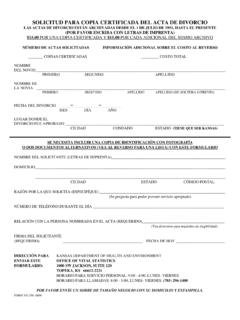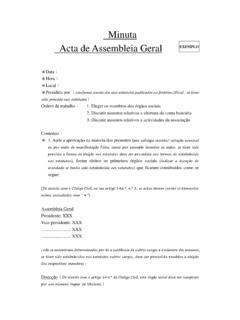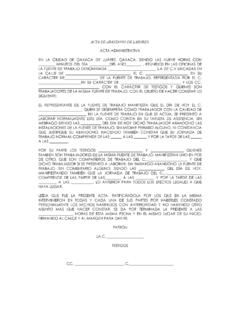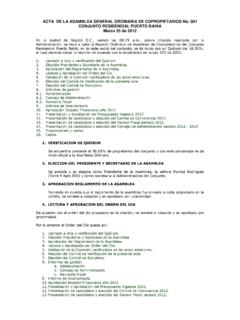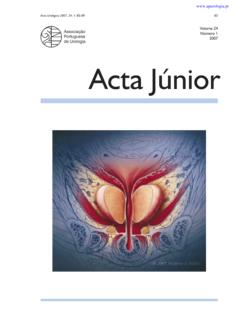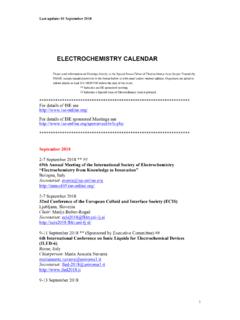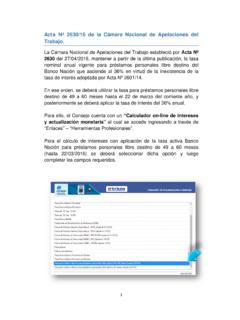Transcription of WHO Child Growth Standards based on length/height, …
1 WHO Child Growth Standards based on length /height, weight and ageWHO MULTICENTRE Growth REFERENCE STUDY GROUP1,21 Department of Nutrition, world health organization , Geneva, Switzerland, and2 Members of the WHO MulticentreGrowth Reference Study Group (listed at the end of the first paper in this supplement)AbstractAim:To describe the methods used to construct the WHO Child Growth Standards based on length /height, weight and age,and to present resulting Growth :The WHO Child Growth Standards were derived from an internationalsample of healthy breastfed infants and young children raised in environments that do not constrain Growth . Rigorousmethods of data collection and standardized procedures across study sites yielded very high-quality data. The generation ofthe Standards followed methodical, state-of-the-art statistical methodologies. The Box-Cox power exponential (BCPE)method, with curve smoothing by cubic splines, was used to construct the curves.
2 The BCPE accommodates various kindsof distributions, from normal to skewed or kurtotic, as necessary. A set of diagnostic tools was used to detect possible biasesin estimated percentiles or z-score :There was wide variability in the degrees of freedom required for thecubic splines to achieve the best model. Except for length /height-for-age, which followed a normal distribution, all otherstandards needed to model skewness but not kurtosis. length -for-age and height-for-age Standards were constructed byfitting a unique model that reflected the average difference between these two measurements. The concordancebetween smoothed percentile curves and empirical percentiles was excellent and free of bias. Percentiles and z-score curvesfor boys and girls aged 0 /60 mo were generated for weight-for-age, length /height-for-age, weight-for- length /height (45 to110 cm and 65 to 120 cm, respectively) and body mass :The WHO Child Growth Standards depict normal Growth under optimal environmental conditions and canbe used to assess children everywhere, regardless of ethnicity, socio-economic status and type of Words:Body mass index, Growth Standards , height, length , weightIntroductionNearly three decades ago, an expert group convenedby the world health organization (WHO) recom-mended that the National Center for health Statistics(NCHS) reference data for height and weight be usedto assess the nutritional status of children around theworld [1].
3 This recommendation was made recogniz-ing that not all of the criteria the group used toselect the best available reference data had been reference became known as the NCHS/WHOinternational Growth reference and was quicklyadopted for a variety of applications regarding bothindividuals and limitations of the NCHS/WHO reference arewell known [2 /5]. The data used to construct thereference covering birth to 3 y of age came from alongitudinal study of children of European ancestryfrom a single community in the United States. Thesechildren were measured every 3 mo, which is inade-quate to describe the rapid and changing rate ofgrowth in early infancy. Also, shortcomings inherentto the statistical methods available at the time forgenerating the Growth curves led to inappropriatemodelling of the pattern and variability of Growth ,particularly in early infancy. For these likely reasons,the NCHS/WHO curves do not adequately representearly childhood origin of the WHO Multicentre GrowthReference Study (MGRS) [6] dates back to the early1990s when the WHO initiated a comprehensivereview of the uses and interpretation of anthropo-metric references and conducted an in-depth analysisof Growth data from breastfed infants [2,7].
4 Thisanalysis showed that breastfed infants from well-offhouseholds in northern Europe and North America( the WHO pooled breastfed data set) deviatednegatively and significantly from the NCHS/WHOreference [2,7]. Moreover, healthy breastfed infantsfrom Chile, Egypt, Hungary, Kenya and ThailandISSN 0803-5326 print/ISSN 1651-2227 online#2006 Taylor & FrancisDOI: : Mercedes de Onis, Study Coordinator, Department of Nutrition, world health organization , 20 Avenue Appia, 1211 Geneva 27,Switzerland. Tel: /41 22 791 3320. Fax: /41 22 791 4156. E-mail: P diatrica, 2006; Suppl 450: 76 /85showed similar deviations when compared to theNCHS/WHO reference but not when compared tothe WHO pooled breastfed group [2]. Finally, thevariability of Growth in the pooled breastfed data setwas significantly lower than that of the NCHS/WHOreference [2]. It was unclear whether the reducedvariability reflected homogeneity in the WHO pooledbreastfed group*/perhaps because of uniformity ininfant feeding patterns*/or unphysiological variabilityin the NCHS/WHO reference.
5 The data for infantsused in the NCHS/WHO reference were collectedbetween 1929 and 1975. The majority of theseinfants were fed artificial milks which, with increasingknowledge about the nutritional needs of infants,changed in formulation over time. It is thus possiblethat the greater variability in the current internationalreference reflects responses to formulas of varyingnutritional quality over four review group concluded from these and relatedfindings that new references were necessary becausethe current international reference did not adequatelydescribe the Growth of children. Under these circum-stances, its uses to monitor the health and nutritionof individual children or to derive population- based estimates of Child malnutrition are review group recommended a novel approach:that a standard rather than a reference be speaking, a reference simply serves as ananchor for comparison, whereas a standard allowsboth comparisons and permits value judgments aboutthe adequacy of Growth .
6 The MGRS breaks newground by describing how childrenshouldgrow whennot only free of disease but also when reared followinghealthy practices such as breastfeeding and a non-smoking MGRS is also unique because it includeschildren from around the world : Brazil, Ghana, India,Norway, Oman and the USA. In a companion paperin this volume [8], the length of children is shownto be strikingly similar among the six sites, withonly about 3% of variability in length being due tointer-site differences compared to 70% for individualswithin sites. Thus, excluding any site has little effecton the 3rd, 50th and 97th percentile values, andpooling data from all sites is entirely justified. Thestriking similarity in Growth during early childhoodacross human populations means either a recentcommon origin as some suggest [9] or a strongselective advantage across human environmentsassociated with the current pattern of Growth key objectives of this article are 1) to providean overview of the methods used to construct thestandards for length /height-for-age, weight-for-age,weight-for- length /height and BMI-for-age, and 2) topresent some of the resulting curves.
7 Complete detailsand a full presentation of charts and tables pertainingto the Standards are available in a technical report [10]and on the Web: and design of the MGRSThe MGRS (July 1997 /December 2003) was apopulation- based study taking place in the citiesof Davis, California, USA; Muscat, Oman; Oslo,Norway; and Pelotas, Brazil; and in selected affluentneighbourhoods of Accra, Ghana, and South Delhi,India. The MGRS protocol and its implementationin the six sites are described in detail elsewhere [6].Briefly, the MGRS combined a longitudinal compo-nent from birth to 24 mo with a cross-sectionalcomponent of children aged 18 /71 mo. In the long-itudinal component, mothers and newborns werescreened and enrolled at birth and visited at home atotal of 21 times on weeks 1, 2, 4 and 6; monthly from2 /12 mo; and bimonthly in the second year. In thecross-sectional component, children aged 18 /71 mowere measured once, except in the two sites (Braziland the USA) that used a mixed-longitudinal designin which some children were measured two or threetimes at 3-mo intervals.
8 Both recumbent length andstanding height were measured for all childrenaged 18 /30 mo. Data were collected on anthropo-metry, motor development, feeding practices, childmorbidity, perinatal factors, and socio-economic,demographic and environmental characteristics [11].The study populations lived in socio-economicconditions favourable to Growth , where mobility waslow,]/20% of mothers followed WHO feedingrecommendations and breastfeeding support wasavailable [11]. Individual inclusion criteria were: noknown health or environmental constraints to Growth ,mothers willing to follow MGRS feeding recommen-dations ( exclusive or predominant breastfeedingfor at least 4 mo, introduction of complementaryfoods by 6 mo of age, and continued partial breast-feeding to at least 12 mo of age), no maternal smokingbefore and after delivery, single term birth, andabsence of significant morbidity [11].As part of the site-selection process in Ghana,India and Oman, surveys were conducted to identifysocio-economic characteristics that could be used toselect groups whose Growth was not environmentallyconstrained [12 /14].
9 Local criteria for screeningnewborns, based on parental education and/or in-come levels, were developed from those survey data for this purpose wereavailable from Brazil, Norway and the USA. Ofthe 13741 mother /infant pairs screened for thelongitudinal component, about 83% were ineligible[15]. A family s low socio-economic status was themost common reason for ineligibility in Brazil,WHO Child Growth Standards77 Ghana, India and Oman, whereas parental refusal wasthe main reason for non-participation in Norway andthe USA [15]. For the cross-sectional component,69% of the 21510 subjects screened were excluded forreasons similar to those observed in the low-birthweight (B/2500 g) infants ( )werenotexcluded. Since it is likely that, in well-offpopulations, such infants represent small but normalchildren, and their exclusion would have artificiallydistorted the Standards lower percentiles.
10 Eligibilitycriteria for the cross-sectional component were thesame as those for the longitudinal component with theexception of infant feeding practices. A minimum of 3mo of any breastfeeding was required for participantsin the study s cross-sectional methodsData collection teams were trained at each site duringthe study s preparatory phase, at which time measure-ment techniques were standardized against one of twoMGRS anthropometry experts. During the study,bimonthly standardization sessions were conductedat each site. Once a year, the anthropometryexpert visited each site to participate in these sessions[16]. Results from the anthropometry standardizationsessions are reported in a companion paper in thisvolume [17]. For the longitudinal component of thestudy, screening teams measured newborns within24 h of delivery, and follow-up teams conductedhome visits until 24 mo of age. The follow-up teamswere also responsible for taking measurements in thecross-sectional component involving children aged18 /71 mo [11].










